
|   |

|   |
Nrithya Vaibhava - Dr. M Surya Prasad e-mail: drmsuryaprasad@gmail.com March 15, 2013 An attractive and committed Bharatanatyam dancer, Aishwarya Nithyananda’s presentation at Bangalore’s Gayana Samaj on Feb 25, the first day of the three day Nrithya Vaibhava, confirmed once again that she is a great artiste in the anvil. Trained rigorously under Guru Radha Sridhar, the effortless ease with which she executed the difficult adavus and her natural expression of even the subtlest emotions through her face and eyes, coupled with hand gestures and body movements, marked her out as a complete artiste. Excellently backed up by KRV Pulikeshi (nattuvangam), Balasubramanya Sharma (vocal), Jayaram (flute) and VR Chandrasekhar (mridangam), her artistry climaxed in the elaboration of the famous krithi Mahadeva Shiva Shambho (Revathi) with a shloka prelude. In this she revealed her originality of thought and interpretation by delineating the tale of Ravana, his devotion, creation of Ravana veena made of his veins and nerves and ultimately Lord Shiva granting him his Atma Linga. 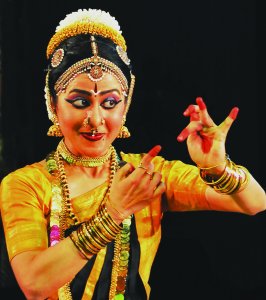 Aishwarya Nithyananda 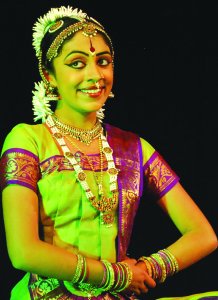 Divya Hosakere This was preceded by a neat Bharatanatyam performance by an enthusiastic Divya Hosakere, who danced in a lithe manner, sweet of face and graceful in form. The ease and control of movements and accurate footwork in micro-precise coordination with the beats of the tala was admirable. She explicated the Vatsalya (motherly love) of Goddess Parvathi and the episodes woven around her sons with success. However, the insertion of the familiar shloka Aygiri Nandini drew a mixed response. Divya’s abhinaya for Shaatodari Shankari and the energetic nritta proved her theatrical mettle. The rendition of a Purandaradasa pada Kadagola tarenna (Yamunakalyani, all about child Krishna) and the Valachi tillana was splendid. Her guru Praveen Kumar (nattuvangam), Vasudha Balakrishna (vocal), Narasimhamurthy (flute) and Srihari (mridangam) enriched her dance. 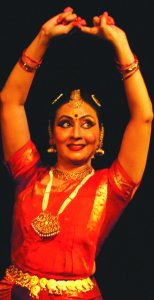 Poornima Ashok On the next day, Poornima Ashok rose to great heights, as her feet beat out the steps, her hands grasped the mudras, her face reflected the emotions and her eyes conveyed the sringara and vipralamba (separation) in particular. Her recital was clean in focus, the movements precise in kala pramana and her abhinaya, unerring in taste. She danced the majestic Nattakuranji varnam (Swami naan) and Vishamakaara Kannan (folk style) with ease and elegance. She built up a magnificent edifice of pure nritta, her rhythmic embellishments growing deeper in fluency and grace, as the strains of the songs filled the hall. She was graceful and expressive in every detail of her exposition of a Mugdha nayika for a Swati Tirunal krithi Swami etu saahasamulu set to Saindhavi raga. She had seasoned accompanists Shakuntala Prabhath (nattuvangam), Srivatsa (vocal), Venugopal (flute) and Srihari (mridangam). 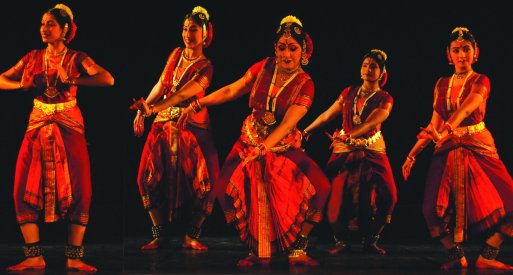 Dr. Vasundhara Doraswamy and group Multi faceted proponent of Bharatanatyam, Mysore’s Dr. Vasundhara Doraswamy’s reputation for otherness glowed strikingly and the lovers of dance were delighted by her and her students’ superbly trained physiques engaging in a refined type of physicality one wishes to associate with Bharatanatyam. Vasundhara packed her group presentations with interesting features on Sri Rama and Sri Krishna. Combining fluid grace with power, her troupe gave an exhibition of high professionalism and hard training grounded totally in the discipline of Bharatanatyam, martial arts and Yoga. Appropriately accompanied by seasoned singer P Ramaa (vocal), Vasudeva Namboodiri (nattuvangam), Jayaram (flute), Janardhan Rao (mridangam) and Karthik (rhythm pad), the dancers led by Vasundhara opened their program with a traditional and rare Pravesha prapthi / poorvaranga pravesha involving salutations to Gods and Ashtadikpaalaas. The group choreography throughout the recital was marked by excellent synchronization, mercurial movements, varying rhythms and vivid and vibrant geometric patterns. In the portrayal of episodes like breaking of Shivadhanush, Seetha Kalyanam and others of Ramayana as per the most familiar Mohana krithi Raara Rajeevalochana, the dancers were impressive. Taana, chittaiswaras, jathis and varieties of adavus made up for a lively nritta. Likewise, with a good dosage of nritta, the varnam Sri Krishna Kamalanatho (Reetigowla) was a successful and effective vehicle for the dancers to take the viewers on a journey of Sri Krishna’s attributes, sports and deeds. For good measure and effect, a Vachana (Swami neene, Revathi) was communicated in an impressive abhinaya. Vasundhara Doraswamy’s dance, in particular, was like a fine tuned instrument. Her body and spirit, technique and abhinaya struck perfect harmony. Her arms turned and formed angles with consummate grace. On the concluding day, veteran art critic and journalist SN Chandrasekhar was felicitated with the lifetime achievement award of Parangatha Prashasthi. 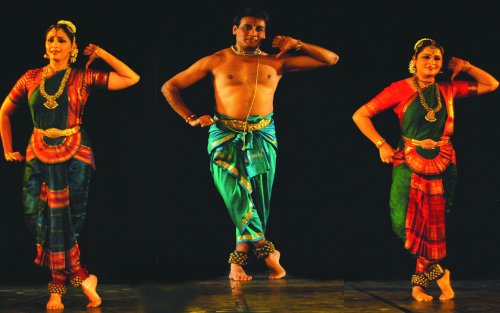 Soundarya Srivatsa, Sathyanarayana Raju & Subhashini Vasanth The eminently talented dancer-trio of Sathyanarayana Raju, Soundarya Srivatsa and Subhashini Vasanth’s dance feature Thyagaraja Vaibhavam provided the grand finale. The intent and contents of six compositions by Thyagaraja was the crux of their performance. The Nagaswaravali Pushpanjali was followed by Nidhi chaala sukhama (Kalyani, highlighting the devotion to Lord Rama), Naada tanumanisham (Chittaranjani raga, on Shiva), Maa Janaki (Kambhoji, underscoring the greatness of Seetha by Sathyanarayana Raju), Gaana moorthe (depiction of the abduction of Rukmini) and the eternal Endaro Mahanubhavulu (Sri, all the three danced together). Their choreography blended the traditional facets of dance with virtuosic features smoothly and resourcefully and all these, including the complex jathis were presented by them with delicate artistic touch which signified their mastery. If the brilliance and breathtaking verve of their nritta enthralled the audience, their abhinaya projected the spirit and ideal of our classical dance heritage. The dance unfolded in a sort of ecstatic mood, in which the performers and the viewers seemed to flow in the same stream of consciousness. Due to the fine support extended by Srivatsa (vocal), Lingaraju (mridangam) and others, music and dance met in a state of harmony. The evening passed in a joyous experience of melody, movement and rhythm, patterned in a seamless mesh. Dr. M. Surya Prasad is a well known Academy awardee dance and music critic. He is a regular columnist for Prajavani (every Tuesday) and The New Indian Express (every Monday). He has published more than 4500 articles and completed more than 1300 columns of writing in English and Kannada. He is the Professor and Head of the Dept. of Hindi, Vijaya College. |